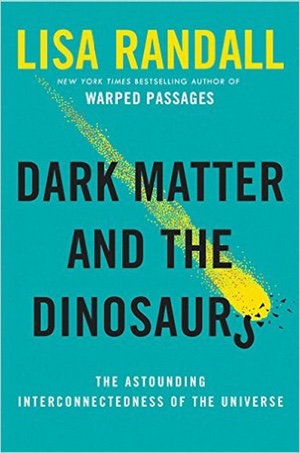Review: Dark Matter and the Dinosaursby Jeff Foust
|
| Randall lets the reader know immediately that she’s proposing an explanation for mass extinctions, not the explanation: “I’ll tell you right up front that I don’t yet know if this idea is correct.” |
More recently, physicist Lisa Randall of Harvard University and colleagues proposed an alternative mechanism for triggering periodic comet storms, invoking a hypothesized disk of dark matter in the galactic plane that our solar system periodically passes through. That proposal, and a bigger picture of how seemingly unrelated concepts—here, dark matter and dinosaurs—can be connected, is at the heart of Randall’s new book, Dark Matter and the Dinosaurs.
Randall lets the reader know immediately that she’s proposing an explanation for mass extinctions, not the explanation. “I’ll tell you right up front that I don’t yet know if this idea is correct,” she writes in the book’s introduction. The book is more about setting up the idea of how cosmology, planetary science, and earth science, usually considered distinct fields with limited overlap, can come together to at least produce a cogent explanation for a scientific mystery.
Those connections take some time to develop in the book. Randall takes the reader through an explanation of several topics, including our current understanding of dark matter, our knowledge of the solar system, and the geologic record of the Earth, including how scientists blamed the demise of the dinosaurs on a massive impact. While there’s a clear link between the solar system and the dinosaur-killing impact, the role dark matter plays is not immediately obvious to the reader.
It’s only in the book’s final section does Randall try to tie everything together. With other explanations for periodic extinctions, like Nemesis, falling short, she hypothesizes that a special type of dark matter that interacts with itself (regular dark matter interacts neither with itself nor with ordinary matter) could condense into a disk in the galactic plane. When the Sun passes through the plane as it circles the Milky Way, it would be subjected to additional gravitational forces from that dark matter disk—enough, she argues, to perturb the Oort Cloud and rain comets into the inner solar system, causing impacts like the one that killed off the dinosaurs.
| That final section, where Randall connects the dots, shows that “interconnectedness” of science promised in the book’s subtitle but missing up until that point. |
But, she acknowledges, we don’t yet know if that disk of dark matter, or even the special type of dark matter required for it to form, exists. Europe’s Gaia spacecraft, launched in 2013 to create a three-dimensional map of the galaxy, will help astronomers understand the Milky Way’s mass distribution, and thus if there is a dark matter disk. It will be several more years, though, before Gaia collects all its data and astronomers analyze it to see if such a disk exists. Even then, there are still debates about how periodic impacts really are, if they really are periodic: while Rampino argues for a cycle of 26 million years, Randall’s book cites a periodicity of 32–35 million years.
It’s that last part of the book that is the most speculative, but also the most entertaining. The previous sections, setting up that explanation with background on various topics, cover a lot of familiar ground for those already familiar with them. That final section, where Randall connects the dots, shows that “interconnectedness” of science promised in the book’s subtitle but missing up until that point. Just how “astounding” those connections turn out to be, though, will depend on how accurate it is.
